Digital Twin Solution Market Size Analysis, By Technology (IOT, AI & ML, AR/ VR / MR, Cloud Computing, BlockChain), By Type (Component Twins/Parts Twins, Asset Twins, System or Unit Twins, & Process Twins), By Deployment (Cloud, On-premise), by Enterprise (Large Enterprises, and Small & Medium Enterprises (SMEs), By Application (Predictive Maintenance, Business Optimization, Product Design & Development, Performance Monitoring), By Industry (Automotive & Transportation, Aerospace & Defense, Energy & Utilities, Infrastructure, Healthcare, Oil & Gas, Telecommunications, Agriculture, Retail) and By Region; Global Insights & Forecast (2024 - 2030)
The Digital Twin Solution Market is expected to grow from USD 9.2 billion in 2023-e to USD 123.6 billion by 2030, at a CAGR of 51.5 % during the forecast period. The digital twin solution market is competitive, the prominent players in the digital twin market include ABB, ANSYS, Autodesk, AVEVA Group, Amazon Web Services, Dassault Systèmes, General Electric, Hexagon, IBM, Microsoft, PTC, Rockwell, Automation, SAP, and Siemens. Digital twin technology significantly reduce construction costs by enabling early detection of issues, reducing waste, and increasing efficiency making them more affordable and accessible to industry players.
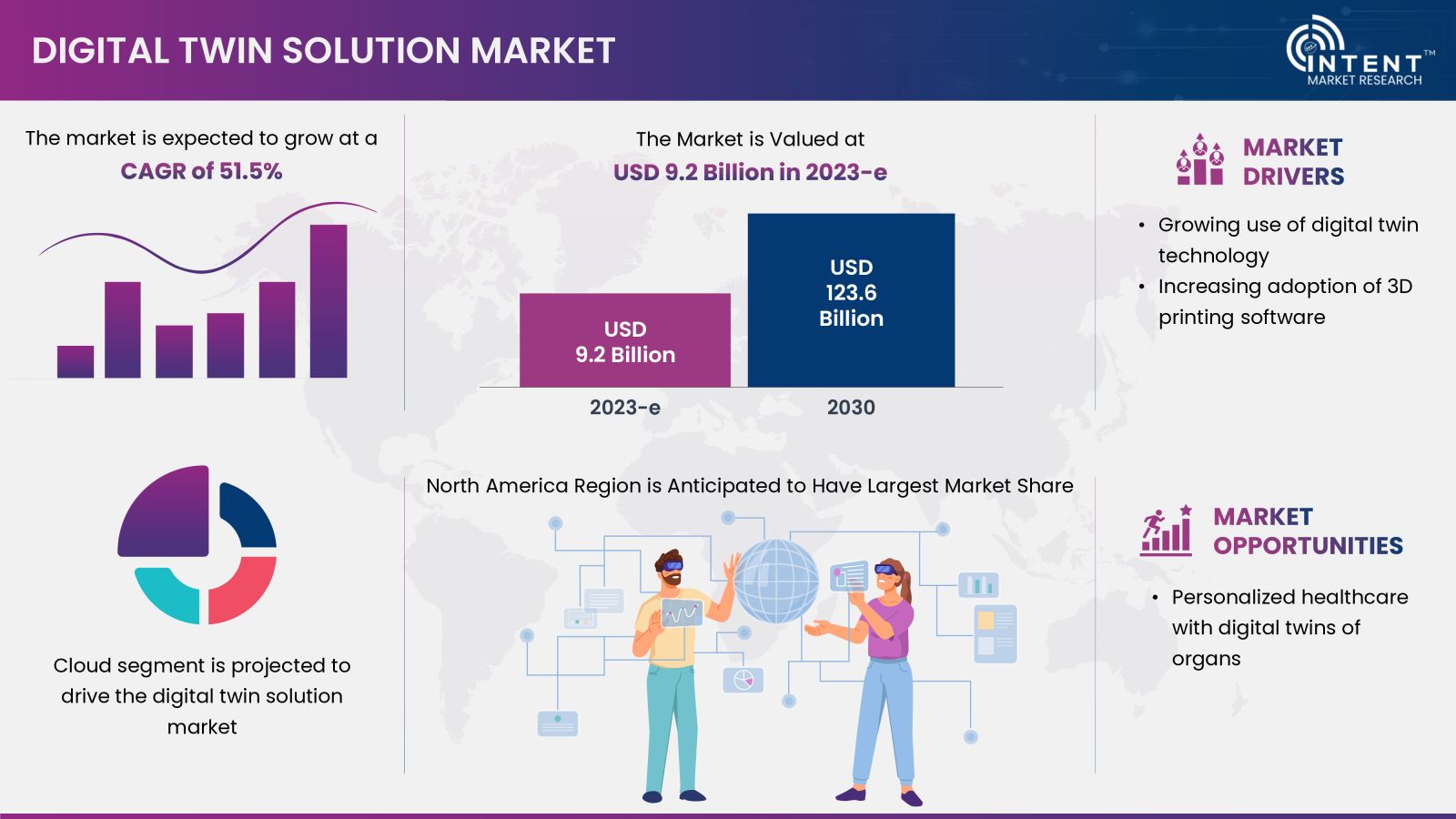
Click here to: Get FREE Sample Pages of this Report
The digital twin solution market is expected to grow significantly over the forecast period due to its transformative impact across various industries. It enables real-time monitoring, analysis, and simulation of their counterparts. This technology offers unprecedented insights into the performance, behavior, and maintenance needs of physical assets, empowering organizations to optimize processes and enhance efficiency.
In manufacturing industry, digital twin solution streamline production by facilitating predictive maintenance and quality control, reducing downtime and costs. In healthcare, they support personalized medicine through detailed simulations of individual patients. Increasing complexity of systems, coupled with the growing availability of Internet of Things (IoT) data, fuels the demand for digital twins.
Their applications extend to smart cities, energy management, and logistics, making them a valuable tool for innovation and decision-making in today's data-driven world. The demand for digital twin solution continue to grow as industries recognize the potential for improved performance and resource utilization, thereby driving ongoing research and development in this space.
Digital Twin Solution Market Dynamics
The value of virtual replicas in digital twin solution market is experiencing significant growth driven by the growing utilization of digital twin solution across diverse industries. Businesses are increasingly recognizing the optimizing operations, enhancing efficiency, and gaining real-time insights into physical assets.
The widespread adoption of predictive maintenance models across various industries propels market growth by enabling proactive and cost-effective asset management. The emergence of personalized healthcare through the utilization of digital twins of organs is an innovative approach which involves the creation and utilization of digital replicas or twins of individual organs, allowing for a highly personalized and tailored healthcare experience. By leveraging advanced technologies, such as artificial intelligence and real-time data analytics, these digital twins enable a comprehensive understanding of an individual's organ functions, characteristics, and potential health risks. This does enhance the diagnostic accuracy but also empowers healthcare professionals to proactively address health issues, ultimately leading to more effective and individualized patient care.
Digital Twin Solution Market Segment Insights
The Dynamic Growth of Digital Twins fueled by Emerging Technologies and Integration Strategies
The anticipated growth in the market is expected to be propelled by the integration of emerging technologies such as cloud computing, big data, AI, IoT, and ML into digital twin solutions.
Companies across various industries are increasingly leveraging AI technologies for the creation of the digital twin model, which also pertains to data analytics and predictive analytics. The incorporation of these advanced technologies not only supports effective performance monitoring but also contributes to heightened system productivity and operational efficiency, driving overall market growth.
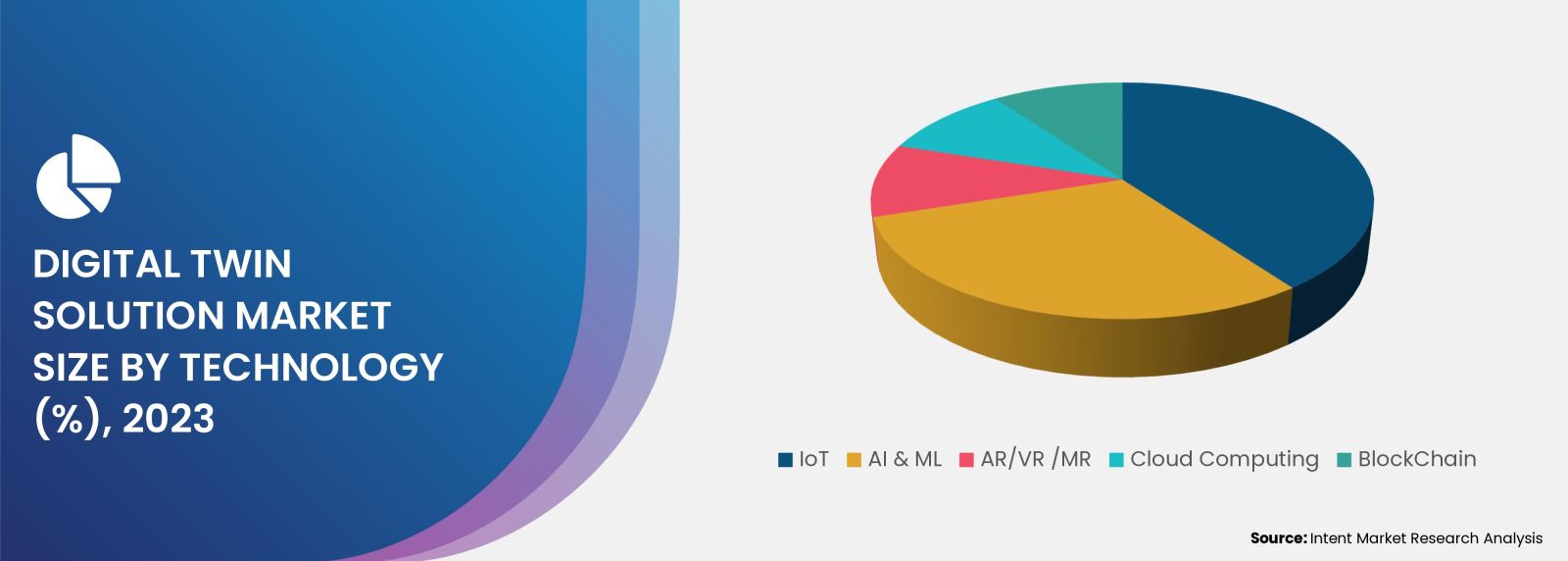
Unleashing the Potential of System Twins in the Digital Twin Solution Market
Incorporations of digital twin solutions enable organizations to revolutionize their products, systems, and processes. It also integrates advanced features encompassing cutting-edge simulation, high-performance computing, AI, data analytics, and IoT capabilities, empowering teams to seamlessly undertake tasks such as design, construction, testing, optimization, evaluation of hypothetical scenarios, and predictive maintenance.
System twins entail the integration of multiple assets, providing engineers with the capability to observe and interpret the synchronized operation of components and overall system performance, thereby bolstering the growth of this particular segment.
On-Premise Segment Offers Higher Flexibility and Cost-Effectiveness to Businesses
Prominent enterprises have crucial business data and opt for complete ownership of solutions to safeguard their information, consequently propelling the growth of this segment. . Cloud-based platforms offer higher flexibility and cost-effectiveness to businesses by reducing investments in installing physical infrastructure and maintenance costs. The increasing demand for cloud-based solutions is driving market players to develop and offer advanced cloud-native digital twin solutions, enhancing the manufacturing process. Moreover, by leveraging cloud-based digital twin solution, manufacturers can simulate, optimize, and predict with greater efficiency and accuracy.
Large Enterprises Segment to Streamline Product Development Timelines
Large enterprises held the majority of the market share in FY2023. This notable market presence is a result of the expanding utilization of digital twins by large enterprises to streamline product development timelines and elevate overall product performance.
The digital twin solution provides comprehensive visibility into the entire product lifecycle and operations, aiding these organizations in strategically planning machinery maintenance and thereby fostering growth within this segment. Concurrently, there is a rising trend of digital twin solution adoption among SMEs, driven by the need to optimize product development costs and the widespread availability of cost-effective solutions.
Rising Interest in Predictive Maintenance, aimed at Sustaining Production Lines, is set to Drive Market Growth
The predictive maintenance market held the majority of the market share in 2023. This proactive approach enables organizations to schedule maintenance activities precisely when needed, minimizing downtime, reducing operational costs, and extending the lifespan of assets. This application is particularly valuable in industries with high-value, complex machinery, such as manufacturing, energy, and transportation, where unplanned downtime can result in significant financial losses.
Significant Boost with the Widespread Adoption of 3D Printing Software in the Automotive and Transportation Sectors
Automotive industry is anticipated to register high growth throughout the forecast period. The considerable market shares in this sector stems from the rising adoption of digital twin solution, fuelled by its diverse advantages such as cost optimization, heightened vehicle safety, and enhanced productivity, contributing to its widespread acceptance.
The adoption of digital twin solution empowers manufacturers and operators to make informed decisions regarding the design, operation, and maintenance of vehicles. Furthermore, it contributes to the improvement of supply chain efficiency by delivering real-time data and insights. Digital twin solution facilitates real-time monitoring of vehicle health, enabling proactive maintenance anticipation and strategic planning. This comprehensive approach enhances decision-making processes and overall operational efficiency within the automotive industry.
The Market Is Flourishing due to the Increasing Adoption for Advanced Industrial Technologies in European Nations
Europe is expected to grow in the forecast period due to the increasing adoption for advanced industrial technologies in European nations. Particularly, the automotive and transportation sector in the region is prominently adopting this technology across various processes. For instance, Robert Bosch and the automotive manufacturer Volkswagen in July 2021, used virtual twin model to enhance the performance of self-driving cars.
Major Industry Players are Enhancing their Positions by actively Developing Digital Twin Platforms
The market for digital twin solution is characterized by intense competition due to the presence of numerous international and domestic players. The digital twin solution market, in particular, is dominated by key players such as ABB, ANSYS, Autodesk, AVEVA, Amazon Web Services, Dassault Systèmes, General Electric, Hexagon, IBM, Microsoft, PTC, Rockwell, Automation, SAP, and Siemens amongst others. These industry leaders are primarily focused on acquiring smaller players and innovating their product lines to cater to changing consumer preferences and needs. The success of market players is heavily dependent on their ability to adapt to changing market trends and consumer preferences.
- In October 2023, Leucine raised USD 7.0 million in series A funds to advance its AI digital twin platform to help drug manufacturers more easily navigate the complex landscape of regulatory compliance
- In November 2023, Siemens Digital Industries Software announced the availability of its PAVE360-driven automotive digital twin solution on Amazon Web Services (AWS). Strengthening the collaborative alliance between Siemens and AWS, empowers developers to streamline the design cycle, reducing time-to-market significantly
- In November 2023, Duality AI, a manufacturer of Falcon, a digital twin announced that it has expanded its capabilities into the cloud, making it possible to access simulations through web browsers
Click here to: Get your custom research report today
Digital Twin Solution Market Coverage
The report provides key insights into the digital twin solution market, and it focuses on technological developments, trends, and initiatives taken by the government in this sector. The report delves into market drivers, restraints, and opportunities, and analyzes key players as well as the competitive landscape within the market. The report offers the market size and forecasts for the digital twin solution market in value (USD billion) for all the above segments
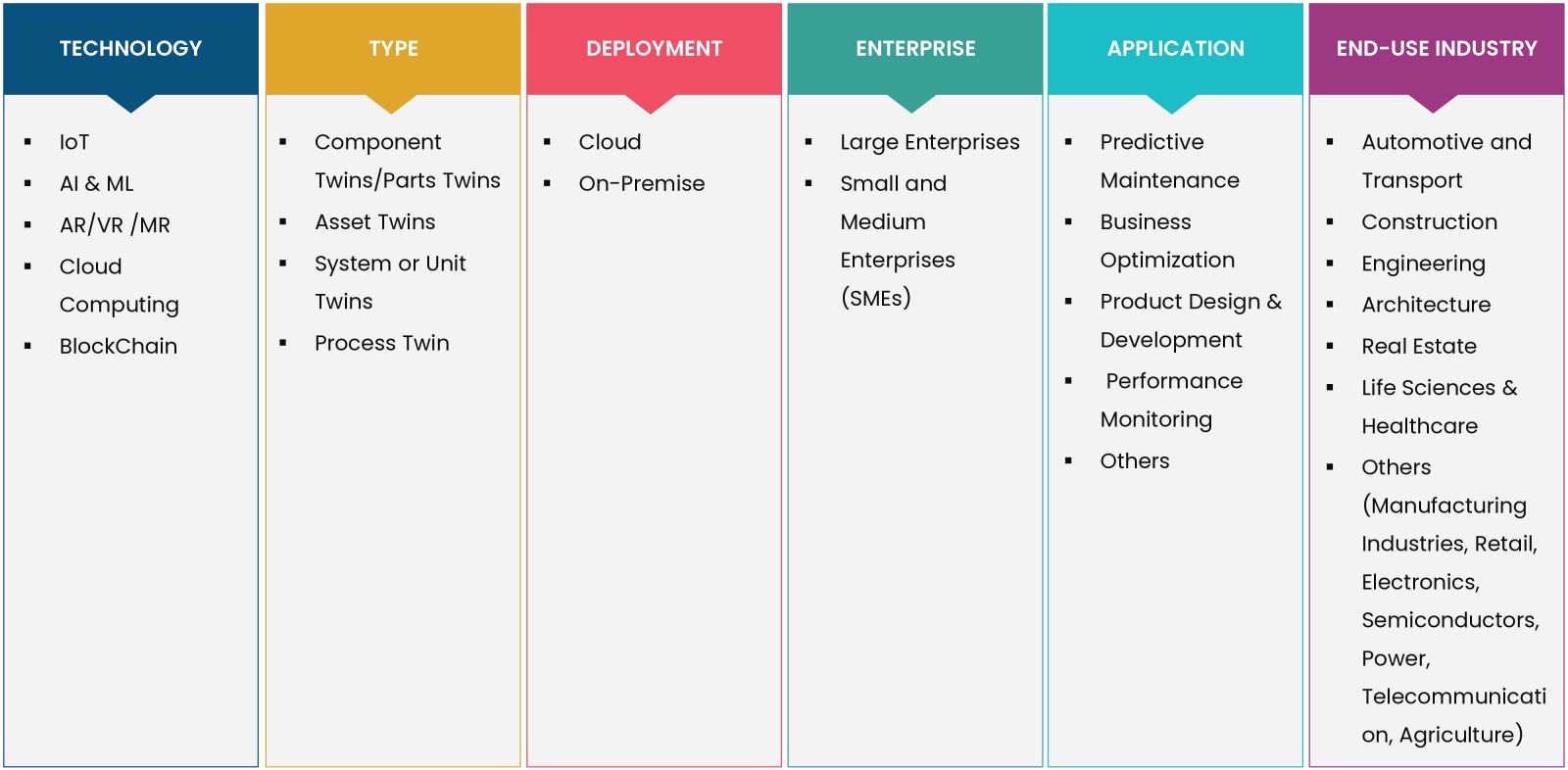
Report Scope
|
Report Features |
Description |
|
Market Size (2023-e) |
USD 9.2 billion |
|
Forecast Revenue (2030) |
USD 123.6 billion |
|
CAGR (2024-2030) |
51.5% |
|
Base Year for Estimation |
2023-e |
|
Historic Year |
2022 |
|
Forecast Period |
2024-2030 |
|
Report Coverage |
Market Forecast, Market Dynamics, Competitive Landscape, Recent Developments |
|
Segments Covered |
By Type (Component Twins/Parts Twins, Asset Twins, System or Unit Twins, and Process Twins), By Deployment (Cloud, On-premise), By Enterprise (Large Enterprises and Small and Medium Enterprises, By Application (Predictive Maintenance, Business Optimization, Product Design and Development, Performance Monitoring and Others), By End-Use Industry (Automotive & Transportation, Aerospace & Defense, Energy & Utilities, Infrastructure, Healthcare, Oil & Gas, Telecommunications, Agriculture, Retail, Others) |
|
Regional Analysis |
North America (US, Canada), Europe (Germany, France, UK, Spain, Italy), Asia Pacific (China, Japan, South Korea, India), Latin America (Brazil, Argentina), Middle East and Africa (Saudi Arabia, South Africa, Turkey, United Arab Emirates) |
|
Competitive Landscape |
ABB, ANSYS, Autodesk, AVEVA Group, Amazon Web Services, Dassault Systèmes, General Electric, Hexagon, IBM, Microsoft, PTC, Rockwell, Automation, SAP, and Siemens |
|
Customization Scope |
Customization for segments, region/country-level will be provided. Moreover, additional customization can be done based on the requirements. |
|
Purchase Options |
We have three licenses to opt for Single User License, Multi-User License (Up to 5 Users), Corporate Use License (Unlimited User and Printable PDF) |
|
1.Introduction |
|
1.1. Study Assumptions and Market Definition |
|
1.2. Scope of the Study |
|
2.Research Methodology |
|
3.Executive Summary |
|
4.Market Dynamics |
|
4.1. Market Growth Drivers |
|
4.1.1.Growing Use of Digital Twin Technology |
|
4.1.2.Increasing Adoption of 3D Printing Software |
|
4.1.3.Increasing Adoption of Predictive Maintenance Model Across Various Industries |
|
4.2. Market Growth Challenges |
|
4.2.1.High Capital Cost to Implement Digital Twin Technology |
|
4.2.2.Risk of Cyberattacks |
|
4.2.3.Skilled Workflow |
|
4.3.Market Growth Opportunities |
|
4.3.1.Personalized Healthcare with Digital Twins of Organs |
|
4.4. Pestle Analysis |
|
4.5. Porter’s Five Forces Analysis |
|
5.Market Outlook |
|
5.1.Overview (Industry Snapshot) |
|
5.2.Technology Roadmap |
|
5.3.Value Chain Analysis |
|
5.4.Pricing Analysis |
|
5.5.Patent Analysis |
|
5.6.Trade Analysis |
|
5.7.Regulatory Landscape |
|
5.8.Key Conferences |
|
5.9.Case Studies |
|
6.Market Segment Outlook (Market Size & Forecast: USD Billion, 2023 – 2030) |
|
6.1. Segment Synopsis |
|
6.2.By Technology |
|
6.2.1.IoT |
|
6.2.2.AI & ML |
|
6.2.3.AR/VR/MR |
|
6.2.4.Cloud Computing |
|
6.2.5.BlockChain |
|
6.3. By Type |
|
6.3.1.Component Twins/Parts Twins |
|
6.3.2.Asset Twins |
|
6.3.3.System or Unit Twins |
|
6.3.4.Process Twins |
|
6.4. By Deployment |
|
6.4.1.Cloud |
|
6.4.2.On-Premise |
|
6.5. By Enterprise |
|
6.5.1.Large Enterprises |
|
6.5.2.Small & Medium Enterprises (SMEs) |
|
6.6. By Application |
|
6.6.1.Predictive Maintenance |
|
6.6.2.Business Optimization |
|
6.6.3.Product Design & Development |
|
6.6.4.Performance Monitoring |
|
6.6.5.Others |
|
6.7. By Industry |
|
6.7.1.Automotive & Transportation |
|
6.7.2.Aerospace & Defense |
|
6.7.3.Energy & Utilities |
|
6.7.4.Infrastructure |
|
6.7.5.Healthcare |
|
6.7.6.Oil & Gas |
|
6.7.7.Telecommunications |
|
6.7.8.Agriculture |
|
6.7.9.Retail |
|
6.7.10. Others |
|
7.Regional Outlook (Market Size & Forecast: USD Billion, 2023 – 2030) |
|
7.1. Global Market Synopsis |
|
7.2. North America |
|
7.2.1.North America Digital Twin Solution Market Outlook |
|
7.2.2.US |
|
7.2.2.1.US Digital Twin Solution Market, By Technology |
|
7.2.2.2.US Digital Twin Solution Market, By Type |
|
7.2.2.3.US Digital Twin Solution Market, By Deployment |
|
7.2.2.4.US Digital Twin Solution Market, By Enterprise |
|
7.2.2.5.US Digital Twin Solution Market, By Application |
|
7.2.2.6.US Digital Twin Solution Market, By End-Use Industry |
|
*Note: Cross-segmentation by segments for each country will be covered as shown above. |
|
7.2.3.Canada |
|
7.3. Europe |
|
7.3.1.Europe Digital Twin Solution Market Outlook |
|
7.3.1.1.Germany |
|
7.3.1.2.UK |
|
7.3.1.3.France |
|
7.3.1.4.Spain |
|
7.3.1.5.Italy |
|
7.4. Asia-Pacific |
|
7.4.1.Asia-Pacific Digital Twin Solution Market Outlook |
|
7.4.1.1.China |
|
7.4.1.2.India |
|
7.4.1.3.Japan |
|
7.4.1.4.South Korea |
|
7.4.1.5.Australia |
|
7.5. Latin America |
|
7.5.1.Latin America Digital Twin Solution Market Outlook |
|
7.5.1.1.Brazil |
|
7.5.1.2.Argentina |
|
7.6. Middle East & Africa |
|
7.6.1.Middle East & Africa Digital Twin Solution Market Outlook |
|
7.6.1.1.Saudi Arabia |
|
7.6.1.2.UAE |
|
8.Competitive Landscape |
|
8.1. Market Share Analysis |
|
8.2. Volume Output Analysis |
|
8.3. Company Strategy Analysis |
|
8.4. Competitive Matrix |
|
9.Company Profiles |
|
9.1.ABB |
|
9.1.1.Company Synopsis |
|
9.1.2.Company Financials |
|
9.1.3.Product/Service Portfolio |
|
9.1.4.Recent Developments |
|
9.1.5.Analyst Perception |
|
*Note: All the companies in the section 9.1 will cover the same sub-chapters as above. |
|
9.2.ANSYS |
|
9.3.Autodesk |
|
9.4.AVEVA Group |
|
9.5.Amazon Web Services |
|
9.6.Dassault Systèmes |
|
9.7.General Electric |
|
9.8.Hexagon AB |
|
9.9.IBM |
|
9.10. Microsoft |
|
9.11. PTC |
|
9.12. Rockwell Automation |
|
9.13. SAP |
|
9.14. Siemens |
Let us connect with you TOC
Intent Market Research employs a rigorous methodology to minimize residual errors by carefully defining the scope, validating findings through primary research, and consistently updating our in-house database. This dynamic approach allows us to capture ongoing market fluctuations and adapt to evolving market uncertainties.
The research factors used in our methodology vary depending on the specific market being analyzed. To begin with, we incorporate both demand and supply side information into our model to identify and address market gaps. Additionally, we also employ approaches such as Macro-Indicator Analysis, Factor Analysis, Value Chain-Based Sizing, and forecasting to further increase the accuracy of the numbers and validate the findings.
Research Approach
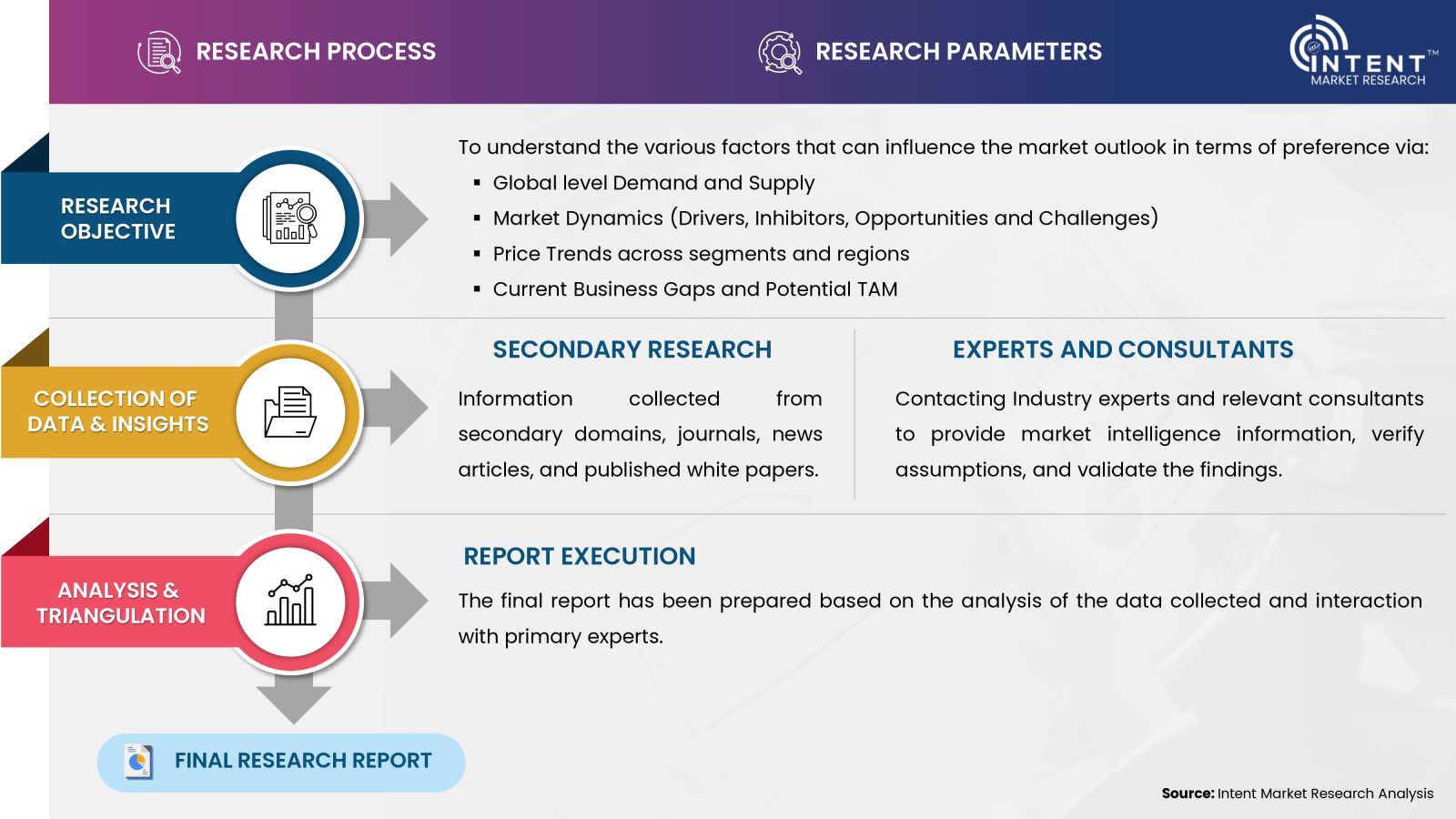
- Secondary Research Approach: During the initial phase of the research process, we acquire and accumulate extensive data continuously. This data is carefully filtered and validated through a variety of secondary sources.
- Primary Research Approach: Following the consolidation of data gathered through secondary research, we initiate a validation and verification process to verify all the market numbers and assumptions by engaging with the subject matter experts.
Data Collection, Analysis and Interpretation:
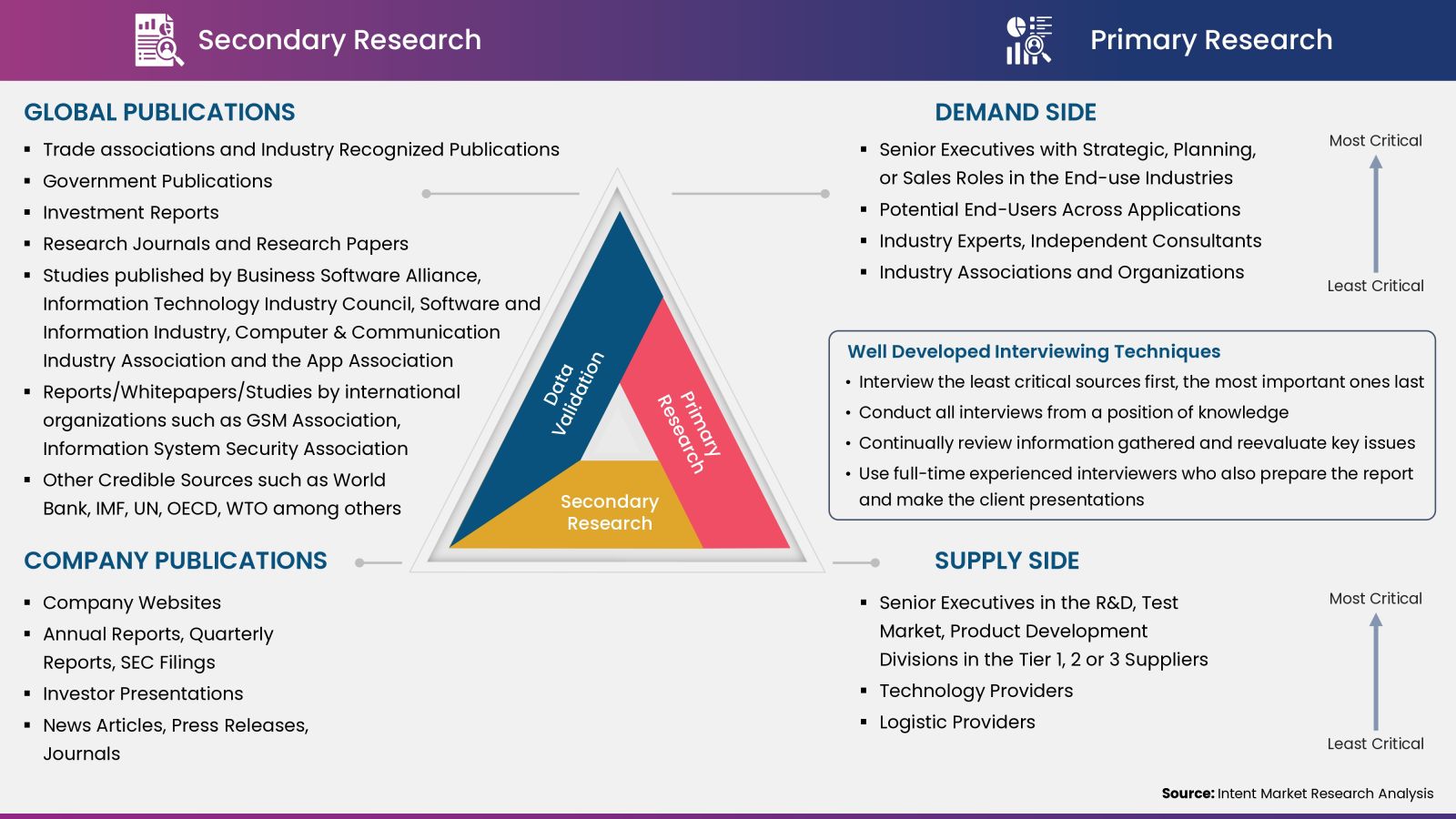
Research Methodology
Our market research methodology utilizes both top-down and bottom-up approaches to segment and estimate quantitative aspects of the market. We also employ multi-perspective analysis, examining the market from distinct viewpoints.
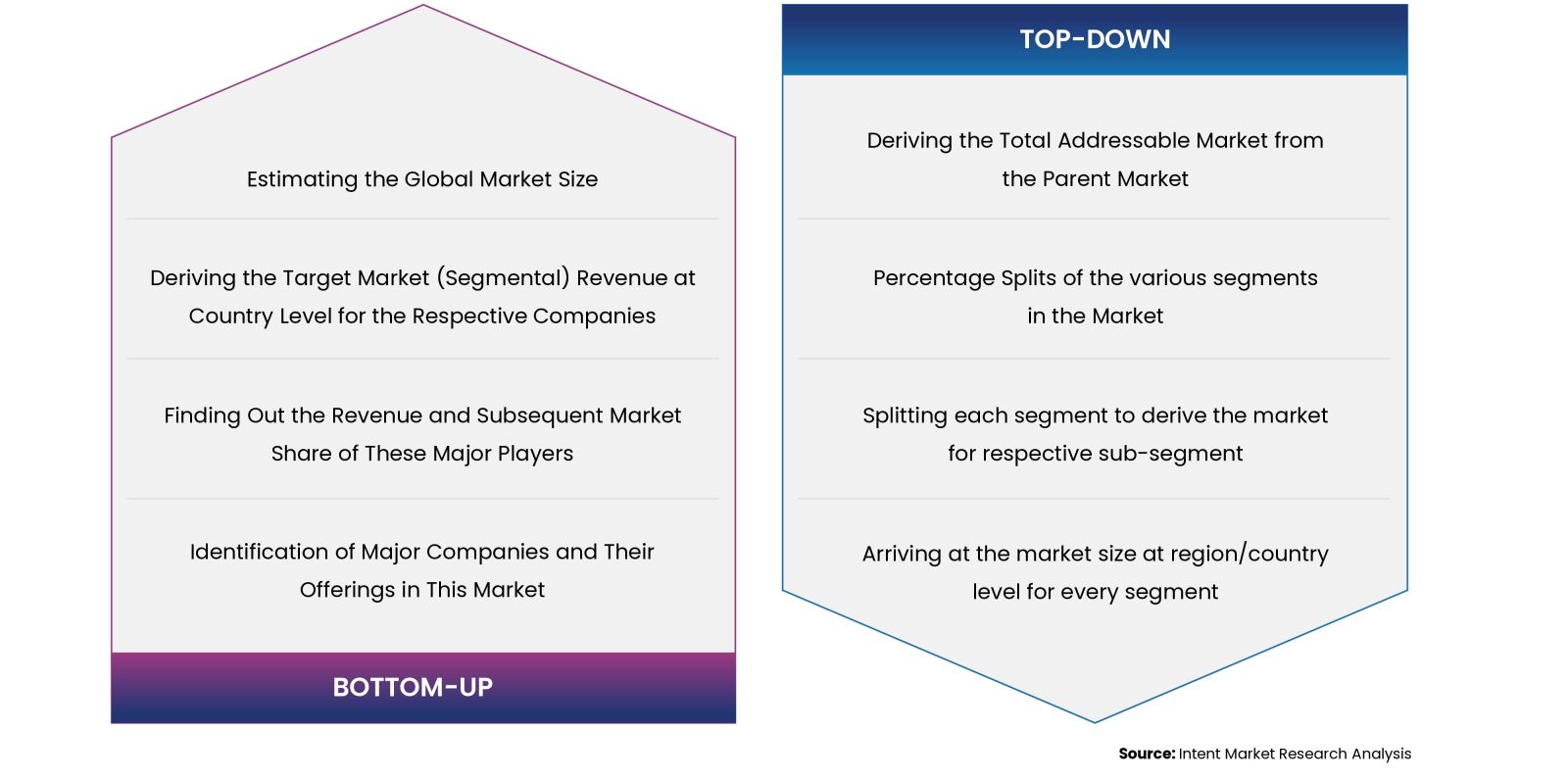
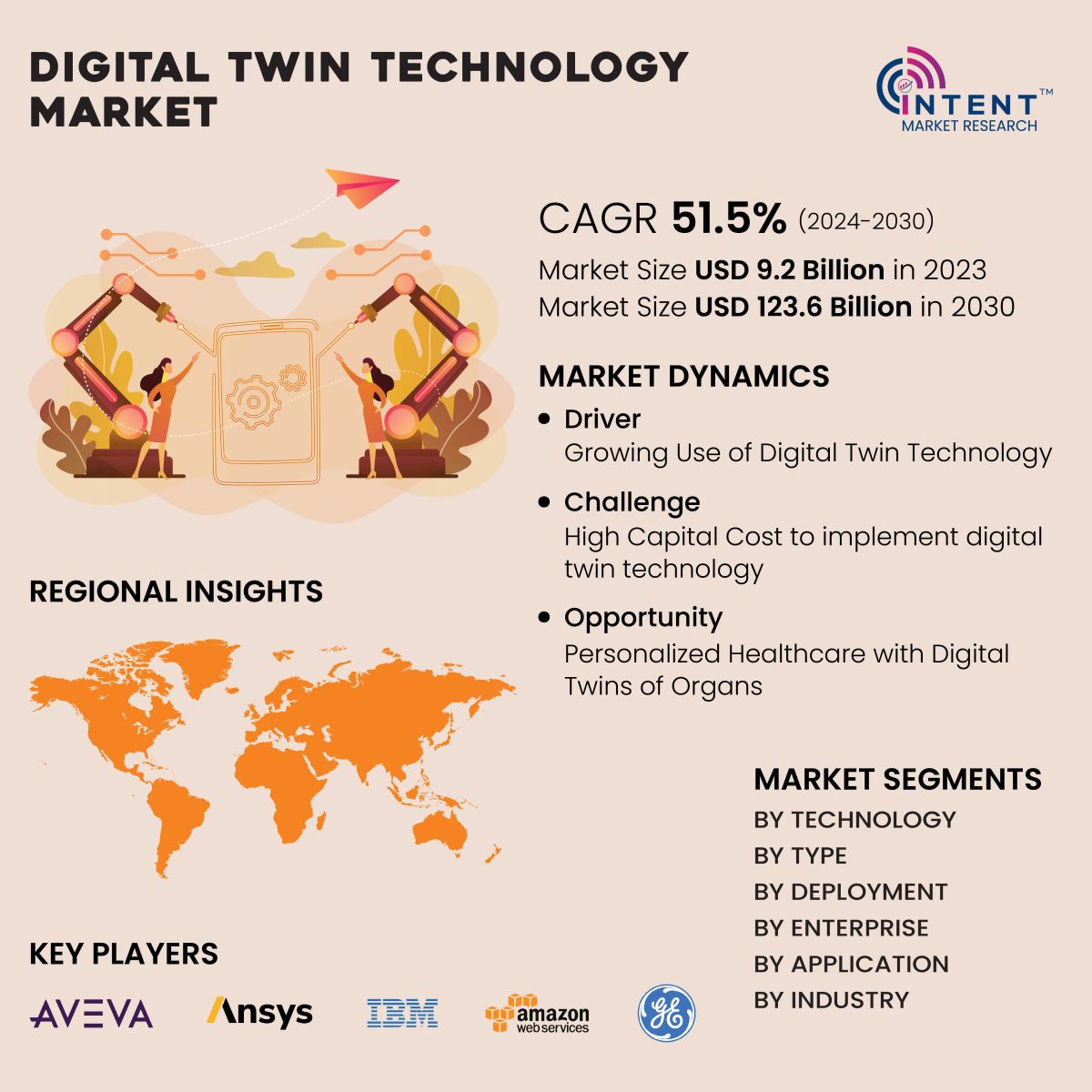
Available Formats


